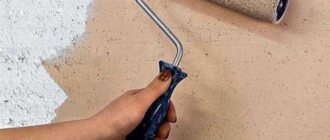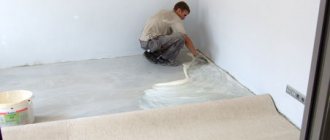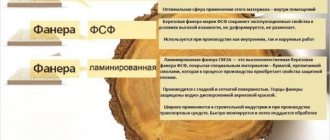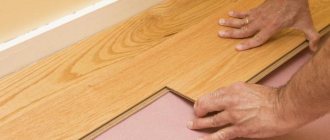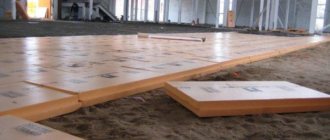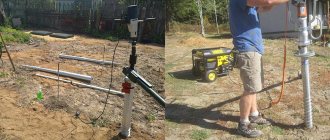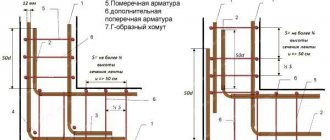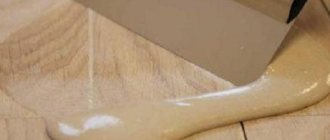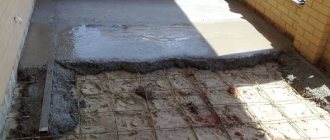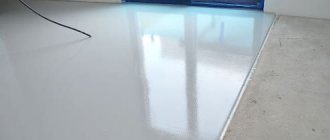The backing for linoleum is a thin building material, most often in roll form, with high elasticity and good thermal insulation properties. It is placed to smooth out minor irregularities and extend the service life of the coating, insulate floors and improve sound insulation.
Rationale for use
The need for mandatory flooring arises when:
- Installation of floors in private houses and apartments on the ground floor. The lining cannot be considered as a complete replacement for insulation, but its absence in this case is immediately felt.
- Installation on a slightly uneven base. The elastic layer reduces the influence of depressions and protrusions on solid concrete within 2-7 mm.
- Low sound insulation properties of interfloor ceilings. Absorbs most of the noise coming from below, the maximum effect is achieved when repairing floors in old apartment buildings.
- Laying too thin linoleum, without its own backing.
We suggest you read the article How to lay an electric heated floor on concrete under a laminate?
Underlay for linoleum on concrete floor
Most varieties of linoleum brands themselves prevent heat loss and have good soundproofing qualities. However, when finishing concrete floors, especially in apartment buildings, the need to install additional insulation arises in the following cases:
- The premises are located on the ground floor or, worse, in the basement of the building. In this situation, no additional measures to save heat will be superfluous.
- Measurements showed that the floors do not have sufficient sound insulation properties.
- The floor surface is uneven and, for some reason, there is no way to level it.
All this justifies laying the underlayment on a concrete floor. Due to this, you can reduce heating costs, avoid conflicts with neighbors below and minimize problems that often arise when installing furniture and household appliances on uneven surfaces.
Coating features
Everyone strives to make their home cozy and comfortable. Each room of an apartment or house corresponds to its purpose and method of use. Therefore, you need to choose a floor covering for the room that suits its purpose. Popular floor coverings are linoleum and carpet.
In the bedroom and living room, when you want softness, comfort, and a warm atmosphere, you should think about carpet. It is distinguished by comfort and convenience. A carpet is similar to a rug or rug, but it geographically occupies the entire area of the room. The main feature of carpet is its household and hygienic disadvantages. It needs careful care and cleaning so as not to become a breeding ground for bacteria, fungus, dirt and mites.
Linoleum has long been a favorite method of flooring. It received its recognition for its positive qualities: durability, ease of care, quick installation, moisture resistance, variety in the choice of colors and patterns. High-quality and wear-resistant types of linoleum can replace tiles, laminate, and parquet. It is laid in kitchens, hallways and other rooms where quick floor cleaning is needed.
The main disadvantage of this coating is that it is a synthetic material and it gives off a feeling of cold. The last disadvantage can be dealt with using a substrate.
Linoleum is divided into: baseless, foamed, warm base. A warm thick base made of felt or jute has shock-absorbing and heat-insulating properties and does not require additional support. A thin product will highlight all the features of the floor; in this case, a lining is necessary.
Underlay for linoleum on a wooden floor
The situation is somewhat different when laying linoleum on wooden floors. Although the reasons for using additional insulation are much the same as when working on concrete floors, it is often more advisable to level the surface and improve the insulation properties through other measures. For example, using wooden slats and plywood sheets. But, since such preparation is more difficult and the costs are higher, many prefer to make do with elastic materials. They are cheaper, and their installation does not take much time and effort.
But remember - in periodically used country houses, the substrate under linoleum on a wooden floor must be carefully treated with compounds that protect it from fire and rot.
Recommendations
In order not to make a mistake when buying with the quality of the material and to make a good installation of a concrete floor with linoleum, it is worth taking note of a few tips from experienced craftsmen.
- When purchasing, it makes sense to do a small elasticity test: if, when you compress the substrate with your fingers, dents remain on the material, the raw material is not suitable for purchase;
- It is unacceptable to level concrete with gypsum-based mixtures: in damp rooms they peel off in layers, and this material is not designed for heavy weight loads;
- If the floor is cold and level, the underlay is necessary for thermal insulation;
- When preparing the screed method, it is important that it dries completely (on average 28 days);
- You cannot lay fiberglass in rooms with high traffic;
- Before laying, the presence of detergent residues, oil stains and dirt on the concrete surface is unacceptable.
We recommend watching the following video for tips on choosing a substrate.
Laying the substrate is a relatively simple process, but it also has its own characteristics. Before starting work, it is advisable to obtain at least a minimum of knowledge.
- Before purchasing the material, do an elasticity test: if the substrate makes dents when compressed, most likely it will wrinkle significantly during use
- Concrete cannot be leveled with gypsum-based mixtures - in a damp room, the gypsum can peel off, and it will not withstand the optimal load
- For a smooth, cold floor, the underlay is needed as thermal insulation - when choosing, they focus on this property
- After pouring the screed, wait for the full period of concrete to gain strength (28 days), only then install the substrate
- Laying fiberglass in areas where there is a lot of foot traffic is contraindicated.
- Before installation, special attention should be paid to cleaning the base - remove all traces of detergents, dirt, oil stains
Types of substrate
There are many synthetic materials on the market that perform their functions well. But specialists in laying linoleum prefer natural-based substrates. The reasons for such sympathy are obvious:
- Good environmental characteristics. This is especially important in cases where one of the inhabitants of the apartment suffers from hypersensitivity to allergens.
- Abrasion resistance. In most cases, natural fibers are superior to chemically neutral synthetics in this parameter. And since linoleum is elastic and, unlike laminate, is in constant motion, this is really important.
But even among natural materials there are differences. They must be taken into account when choosing a substrate.
- Cork . It does not contain any aggressive chemical additives and has perhaps the highest noise insulation parameters and retains heat perfectly. But if mechanical strength is a decisive factor, the use of a cork substrate will have to be abandoned. It is unlikely that this option will suit those for whom the price of the product plays an important role. Cork backing is expensive.
- Jute . The dried fibers of the plant of the Malvaceae family are highly durable and, being impregnated with special additives, reliably resist rotting and flame. Retaining heat well and preventing the penetration of sounds, such a substrate becomes a good choice for those who are willing to spend money for the quality of the purchased product.
- Linen . Slightly inferior to jute in terms of basic characteristics, this material is much cheaper. This is natural, because flax grows not in Asia or Africa, but in our country. In addition, it is always possible to compensate for differences in parameters by increasing the thickness of the substrate. So you shouldn’t neglect flax.
Recently, composite substrates containing in their composition, in different proportions, all of the listed materials, have become widespread. In this case, the question arises about the integrity of the manufacturer. After all, if the characteristics of individual cork, jute, or flax are known, then they will have to rely on the supplier’s data.
We can only hope that after reading the information provided, you will be able to decide whether a linoleum underlay is needed in your particular case, and if so, which one.
What functions does the substrate perform?
To decide on the choice of a specific material for the role of the substrate, you need to understand exactly what it will be used for. First of all, it is designed to provide compensation for unevenness on the rough surface . In this regard, concrete is one of the most problematic substrates. However, a lot depends on how the screed under the linoleum was made and with what solution. If there are obvious defects, then it is not recommended to lay the decorative coating without a backing, since tiny cracks, depressions and bumps will appear on its surface. The presence of a dense backing will provide the linoleum with good protection and minimize wear .
Sound insulation of the layer is of greater importance when laying creaking laminate flooring, but depending on the characteristics of the linoleum, it can also become a useful performance property. In general, linoleum and concrete are not acoustically problematic materials . But in terms of thermal insulation properties, it is difficult to find a less effective base-coating combination. Cold concrete and thin linoleum in a living room must be supplemented with good insulation.
Return to content
Membrane sound insulators
More recently, when I myself was soundproofing the floor in my apartment, the home craftsman was offered a choice of 2 materials - Isover, 5 and 10 cm thick, and Rockwool.
Today, of course, the choice of materials is much wider. So-called membrane sound-absorbing materials have appeared, which help not only to retain high-pitched sound, but also to cut off vibrations that occur during the propagation of structural sound. These membranes are available in the market in a wide variety of brands and models.
The most common today: Texound, Vibrostop and Schumanet. They are distinguished by their high density and weight, and therefore retain sounds well. Such membranes are ideal for laying linoleum and any other rolled materials.
Soundproofing a floor under linoleum involves installing a small underlay, which will simultaneously serve as a damper and sound insulation. Membrane materials are ideal for such a substrate. You can lay linoleum directly on them.
Soundproofing the floor in an apartment under a dry screed
The dry screed acts as a soundproofing barrier for the floor in the apartment. Its important advantage over a wet screed is that the floor in the apartment can be used immediately after the work is completed.
To create a waterproofing layer, a dry mixture is used, including:
- expanded clay;
- expanded perlite sand;
- granulated slag with a fine fraction;
- dry mix "Knauf".
Stages of arranging a dry soundproofing screed for the floor in an apartment:
- A waterproofing layer is laid on the interfloor ceiling.
- A damper tape is attached along the perimeter of the walls in the place of the proposed screed, the width of which is slightly greater than the calculated height of the floor.
- To indicate the level of dry material filling, it is necessary to set beacons or pull a cord.
- The dry mixture is evenly distributed over the waterproofing to the height indicated by the level and leveled.
- Sheet material is laid on the granular layer: plywood, chipboard, plasterboard, OSB, Knauf-superfloor, etc.) The sheets must be laid in one or two layers and fastened with glue and self-tapping screws.
How to get rid of high-pitched sounds indoors
When soundproofing under linoleum
, the substrate must perform the functions of a shock absorber and protection against the penetration of foreign sounds, both impact and structural. This problem can be solved by improving the “pie”, as they say, the constituent elements of the layers of which are different noise insulators.
For example, the sequence of actions could be as follows:
- First of all, the membrane sound insulation is laid out (this can be a heavy Texound aragonite substrate);
- On top of the first layer are 5-centimeter slabs of Izover (mineral fiberglass wool) or Rockwool. You can also use materials in rolls, which are placed overlapping and fixed at the joints with tape specially prepared for such work.
As a result, this sound insulation under linoleum and impact rumble will significantly reduce structural sounds
It is necessary to take into account that the soundproofing “pie” will reduce the height of the room
Jute
The material is made from natural fiber obtained by processing the stems of the same variety of herbs and shrubs. The use of jute for the manufacture of lining for floor coverings began relatively recently - previously it was used mainly only for the production of burlap and ropes.
The jute substrate has good sound and heat insulation characteristics, is highly environmentally friendly, and provides microventilation. The downside is the relatively high price - on average 100 rubles per square meter.
Just like any other natural materials, it is susceptible to rotting, destruction by fungi and insects. Impregnation with specialized chemicals reduces the vulnerability of the material, but not by 100%. Therefore, it is not recommended to lay jute products in rooms with high humidity.
Measuring linoleum
Before laying linoleum, you need to carefully measure everything, determining the required amount of material and marking the floor where it will be laid. Carefully and carefully measure the length and width of the room, adding an average of 10 centimeters (allowance) to the measurements.
If the linoleum has a pattern that is important to join correctly, more material will be needed, since there will be a lot of waste
The best option is to buy linoleum, the width of which will correspond to the width of the room. In this case, there will be no joints, no need to connect or select anything. If the width of the linoleum is not enough, then you need to immediately buy the required amount of material from one batch, and during the installation process try to make the coating monolithic.
If the design of the floor covering is complex, it is advisable to contact professionals who will help you correctly cut the material into strips of the required size in order to perfectly match the pattern.
Traditional methods of soundproofing floors
There are several most common methods.
- "Soft floor" The simplest and most common way is to lay a soft carpet or synthetic covering on the floor, for example, linoleum on a foam base or felt, carpet, or other carpeting. It's quite easy to do this.
- Very common methods include cement screed poured according to the “floating floor” principle. Its advantages are obvious: it is easy to make a screed and it is relatively inexpensive. The disadvantages are that it takes a long time to dry, sometimes up to several weeks. In addition, the screed significantly burdens the floor and is not permissible in all houses for this reason. If there is permission for the screed, then pouring it is not difficult.
The “floating floor” is good because it isolates the walls from the floor, as well as the floor covering from the interfloor ceilings and walls.
If it is not possible to make a cement screed in your home, you can replace it with a dry screed. it is much lighter than cement-sand. Insulation materials can be used as sound-absorbing materials.
With all the advantages of a “floating floor,” it has its disadvantages, except for those mentioned above. So, mistakes in laying such a floor will negate all efforts and sound insulation will not work
In addition, the screed will “steal” a dozen extra centimeters of height, which is important in our standard low-rise apartments
Therefore, it makes sense to take a closer look at other methods of sound insulation using modern materials.
Laminate - cheap and cheerful
This is an excellent option for renovation. Manufacturers offer such a huge range of laminate flooring that anyone can choose a product that suits their budget.
Laminate is popular among consumers
It turns out that laying laminate flooring is also necessary using a backing. Otherwise, every step will echo throughout the apartment.
Laminate does not like uneven surfaces. It doesn’t matter whether it will be installed on a wooden or concrete base. Leveling the floor before laying laminate flooring is a mandatory and very important procedure. Otherwise, after six months the seams will fall apart and the boards will begin to sag.
Laminate flooring can be laid on the same substrate as linoleum. The main thing is to choose quality materials. Do not skimp on contacting a master who will skillfully turn a concrete floor into a work of art.
Additional screed or subfloor on joists
Even when using heterogeneous linoleum with an additional substrate, the soundproofing properties of the floor can be enhanced during the manufacture of the screed or rough base on the joists.
Sound insulation between joists
A subfloor on joists is a quick and inexpensive way to level and insulate the base. After preparing the base, performing a vapor barrier and attaching the logs, any roll or slab soundproofing material is laid between the bars. For this purpose, materials from basalt mineral wool (“Rockwool” or “Isover”) or modern aragonite texaund are used.
Soundproofing a wooden floor using joists
Pieces of cotton wool are cut with a margin so that it fits tightly between the bars. After laying the insulation under the plywood, additionally roll sound insulation (“Shumostop”, “Isoshum”) is laid.
After laying plywood or OSB, multilayer linoleum is rolled out.
Soundproofing a concrete floor
When installing a new screed (dry, semi-dry or wet), soundproofing boards are laid as the first layer. ISOPLAAT slabs are considered the best option. With a small thickness (2.5 cm), this fibrous material provides noise absorption of up to 26 dB.
The screed is carried out using standard technology, only soundproofing material is laid as the first layer. This substrate is covered with roofing felt or polyethylene and a screed is made.
After the screed has dried, you can additionally lay roll sound insulation and use multilayer linoleum.
